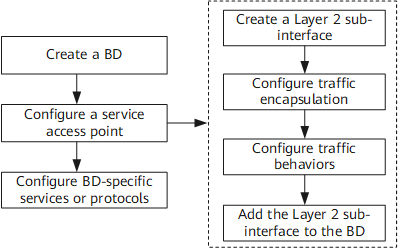Summary of EVC Configuration Tasks
This section describes EVC features supported by the NetEngine 8000 F.
An Ethernet virtual connection (EVC) defines a uniform Layer 2 Ethernet transmission and configuration model. An EVC is defined by the Metro-Ethernet Forum (MEF) as an association between two or more user network interfaces within an Internet service provider (ISP) network. In the EVC model, a bridge domain functions as a local broadcast domain that can isolate user networks.
- Establish an EVC model to forward Layer 2 packets.
- Configure a MAC address table based on bridge domains to guide packet forwarding.
- Configure EVC security attributes to securely transmit packets within bridge domains.
Services or Protocols Supported by EVCs
An EVC defines a uniform Layer 2 service bearer and configuration model. The EVC model can carry services in Table 1, simplifying configuration management and enhancing O&M efficiency.
Service/Protocol Type |
Description |
|
|---|---|---|
IP services |
Local Address Resolution Protocol (ARP) proxy |
To allow isolated users in a BD to communicate, enable local ARP proxy on VBDIF interfaces to implement interconnection. |
Dynamic Host Configuration Protocol (DHCP) server/client |
If a DHCP client and a DHCP server reside on different network segments, a DHCP relay agent must be configured based on BDs to forward DHCP messages between the client and server. DHCP relay allows a single DHCP server to serve DHCP clients on different network segments, reducing costs and facilitating centralized management. |
|
VPN services |
virtual private LAN service (VPLS) |
To allow users connected over a VPLS network to communicate, establish the EVC model on VPLS network edge devices and bind BDs to virtual switch instances (VSIs) for VPLS access. |
Layer 3 virtual private network (L3VPN) |
To allow users connected over a Border Gateway Protocol (BGP)/Multiprotocol Label Switching (MPLS) IP VPN to communicate, establish the EVC model on BGP/MPLS IP VPN edge devices and bind VBDIF interfaces to VPN instances for BGP/MPLS IP VPN access. |
|
Virtual private wire service (VPWS) |
To allow users connected over a VPWS network to communicate, establish the EVC model on VPWS network edge devices and bind Layer 2 sub-interfaces to virtual leased lines (VLLs) for VPWS access. |
|
Multicast services |
Layer 2 multicast |
After IGMP snooping is deployed for a device based on BDs, the device learns whether there are multicast receivers attached to its interfaces by listening to IGMP messages exchanged between the multicast router and hosts. The device then multicasts the packets on the Layer 2 network so that only members in the multicast group can receive the packets. |
Multicast services |
Layer 3 multicast |
After IGMP is deployed on VBDIF interfaces, a multicast forwarding table and routing table are created. When the device receives the multicast protocol packet from the user side, the device can identify and send the packet to the upstream device based on service VLAN tags. When the device sends multicast traffic, the device can replicate and deliver the multicast traffic based on the created multicast forwarding table. |
Reliability |
Virtual Router Redundancy Protocol (VRRP) |
To ensure reliable and stable network communication, deploy VRRP backup groups on the VBDIF interfaces of the gateways to implement redundancy backup between gateways. If the master gateway fails, services are immediately switched to the backup gateway, ensuring communication continuity and reliability. |
Routing protocols |
IS-IS |
To allow users on different network segments in a BD to communicate, deploy a routing protocol to implement Layer 3 reachability.
|
Routing Information Protocol (RIP) |
||
Open Shortest Path First (OSPF) |
||
Border Gateway Protocol (BGP) |
||
NTP |
- |
To implement clock synchronization between devices equipped with clocks on a network so that all devices can have the same clock, deploy NTP on VBDIF interfaces. |
Network monitoring |
Network Quality Analysis (NQA) |
To allow carriers to monitor QoS in real time and perform effective fault location and diagnosis in case a fault occurs, deploy NQA to test network operating status and output statistics. |
Security |
DHCP snooping |
When DHCP servers and clients reside in the same BD, to allow DHCP clients to obtain IP addresses from valid DHCP servers, configure DHCP snooping to defend against bogus DHCP servers. |
Figure 1 shows the flowchart for configuring services or protocols carried over EVCs.
